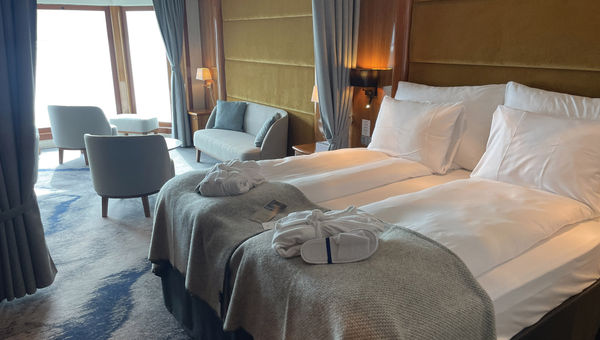“Let me guess: reindeer?”
Though inventive in interpretation, the staples of each meal onboard Hurtigruten’s Trollfjord could be predictable, only because the ship utilizes up to 80% local ingredients. We had tried the antlered protein as a steak, on a flatbread, as jerky, in a sausage, and now it was in a traditional stew.
Sailing our way north along the new Svalbard Express route, from Bergen to Longyearbyen, Norway, we weren’t expecting familiar American fare; this was Hurtigruten Norway, and the entire experience is Norwegian from tip to tail.
In 1893, Hurtigruten — which means “fast route” — began its Coastal Express, ferrying locals between 34 ports along the coast of Norway. Now, as it celebrates its 130th anniversary, a lot has changed for Hurtigruten Expeditions as a cruise line. But not much has changed for its Coastal Express product, referred to as Hurtigruten Norway — until now.
Building upon an effort to attract other global markets to Hurtigruten, including North Americans, the Trollfjord was pulled from the Coastal Express fleet for a refresh before embarking on two new routes for 2023: the North Cape Express and the Svalbard Express, which operate in winter and summer seasons, respectively. Hurtigruten Norway considers this the biggest product evolution in its history.

The writer, right, and her guest paused for a photo when the ship called in Andalsnes. Photo Credit: Brittany Chrusciel
Particularly convenient for North Americans is the ability to do a half-route in place of the full, roundtrip voyage. This is the option we were exercising onboard the Trollfjord’s first sailing of the Svalbard Express that enabled passengers to disembark halfway through. Rather than a 14-night cruise that arrives back in Bergen, we left the ship in Longyearbyen, a small town on Spitsbergen Island, after a week onboard and stayed for a two-night land extension, which is included in the cruise fare.
According to Hurtigruten, North Americans constitute 14% of its passenger base. A heavy mix of Norwegians, Germans, Brits and French meant that all announcements onboard our sailing as well as some lectures and tours were multilingual. Despite basic Norwegian lessons during the daily briefing, you’ll also quickly learn the phrase “dear guests” in at least three other languages. Entertainment is limited to a single lounge singer who performs nightly in the bar.

Each suite onboard has a name; pictured is the Musik Suite, which has a refurbished interior. Photo Credit: Brittany Chrusciel
Sunlight to spare
Still, the Svalbard Express, running from July to September, is selling twice as well with North Americans as the North Cape. Under the midnight sun, the itinerary features all-day illumination as it sails toward the Arctic Circle, with increased chances of seeing wildlife like whales, reindeer and, if the odds are in your favor, a polar bear. The line anticipates that the North Cape route (September to April) will catch on with travelers interested in seeing the aurora borealis. Hurtigruten offers a “northern lights guarantee,” which rebooks guests on another sailing if their cruise did not once encounter the shimmering skyward display.
The Svalbard Express cruise begins and ends in Bergen, while the North Cape Express will sail one way to or from Oslo. The itineraries more closely mimic a classic cruise experience, spending hours in each port in lieu of the sometimes 15-minute calls made when the ship operated as a ferry.
Sixty-three new shore excursions were developed for these revamped itineraries, and the onboard experience has also been tweaked to accommodate longer stays and an international passenger base. This is especially true for the clients who spring for one of the ship’s 15 fully refurbished suites. The Trollfjord has taken Hurtigruten’s fast route and morphed it to fit the growing trend of slow travel.
Changes made to the ship include refreshed cabins, a Norway-inspired beverage program and the addition of fine dining restaurant Rost. Alcoholic drinks and all meals at Rost, including afternoon tea, are included for suite guests. With cozy, standard cabins ranging from 96 to 161 square feet and only five balconies onboard, the up-sell to a suite isn’t a tough one, especially for luxury clients.

Among the upgrades made to the Trollfjord is the addition of fine dining venue Rost, included when booked in a suite. Photo Credit: Brittany Chrusciel
An agent’s view
Curious as to whether this product would appeal to luxury clientele in the U.S., I spoke with fellow passenger Kareem George, founder of the Detroit-based agency Culture Traveler and an ASTA board member.
“It’s always important to manage expectations for a client, but I would position [the Svalbard Express] to someone looking for an authentic experience who’s interested in active options and comfort over luxury,” George said. “For many coastal countries, like Norway, the best way to experience them is by water. The efficiency and value of a cruise –the meals, accommodations and fewer flights — is a unique and compelling revenue proposition.”

Afternoon tea is served daily in Rost; it’s free for suite guests and carries a small charge for other passengers. Photo Credit: Brittany Chrusciel
George said he believes that greater visibility, perhaps through an image campaign or partnership with a North American brand, would help Hurtigruten with brand recognition in the U.S. However, he concedes that despite the line’s lack of recognition with luxury clients in the U.S. compared with cruise lines like Silversea, Hurtigruten has something truly special to offer when it comes to Norway.
“Their brand identity and historic connection to Norway is a strong selling point,” George said. “Luxury clients want experiences that are true to the destination; they crave access to unique and authentic storytellers.”
Concerning the reindeer, George is a vegetarian. He raved about how accommodating the crew had been with his dietary preferences.
“The culinary options onboard are a standout. There are so many local dishes I would have probably never tried otherwise.”
